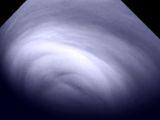Venus' atmosphere is probably the most mysterious of all celestial bodies in the Solar System, presenting an intricate cloud structure which extends between 45 and 70 kilometers above the scorching hot surface. They contain high concentrations of sulphuric acid combined with other aerosols moving at fast speeds, resembling the structure of light fogs, however with much greater thickness which disables the direct observation of the surface of the planet.
Visible, near-infrared and ultraviolet observations carried out with the Venus Monitoring Camera on board ESA's Venus Express spacecraft reveal that the upper atmosphere presents highly varied details due to different concentrations of aerosols. The image featured here shows the southern regions of the planet, and was taken from a distance of about 30,000 kilometers.
The look of the cloud structure in the equatorial regions of the upper atmosphere (up) appears rather spotty and fragmented, meaning that the radiation coming from the Sun is converted into heat, forcing the clouds into a convective movement destined to equalize temperature differences. The brightest cloud structure on top is most likely made of fresh droplets of sulphuric acid.
Towards middle latitudes, the convection movement seems to be somehow weaker, forming streaky clouds which absorb less light coming from the Sun. The scene changes once again towards high latitudes, forming a dense circular cloud structure over the pole which appears to be spiraling around and downwards to the south pole of the planet.
Other images taken by the Venus Express spacecraft while orbiting the planet in an elongated trajectory show similar phenomena taking place in the equatorial regions, while the transition region between the areas of the atmosphere dominated by convective movement and the region located between 40 and 50 degrees latitude, where the streaky clouds appear, seems to be different from the others.
The second image, captured by the Venus Express spacecraft while at an altitude of 20,000 kilometers shows the circular south polar cloud structure, the 'hood', where structure variations take place in a mater of few days. The cloud top appears very bright in ultraviolet and is much more uniform than any other regions of the atmosphere, presenting only scarce dark streaks, evidence of the existence of powerful jet winds.
The cloud structure on Venus appears to have north-south symmetry.

 14 DAY TRIAL //
14 DAY TRIAL // 
